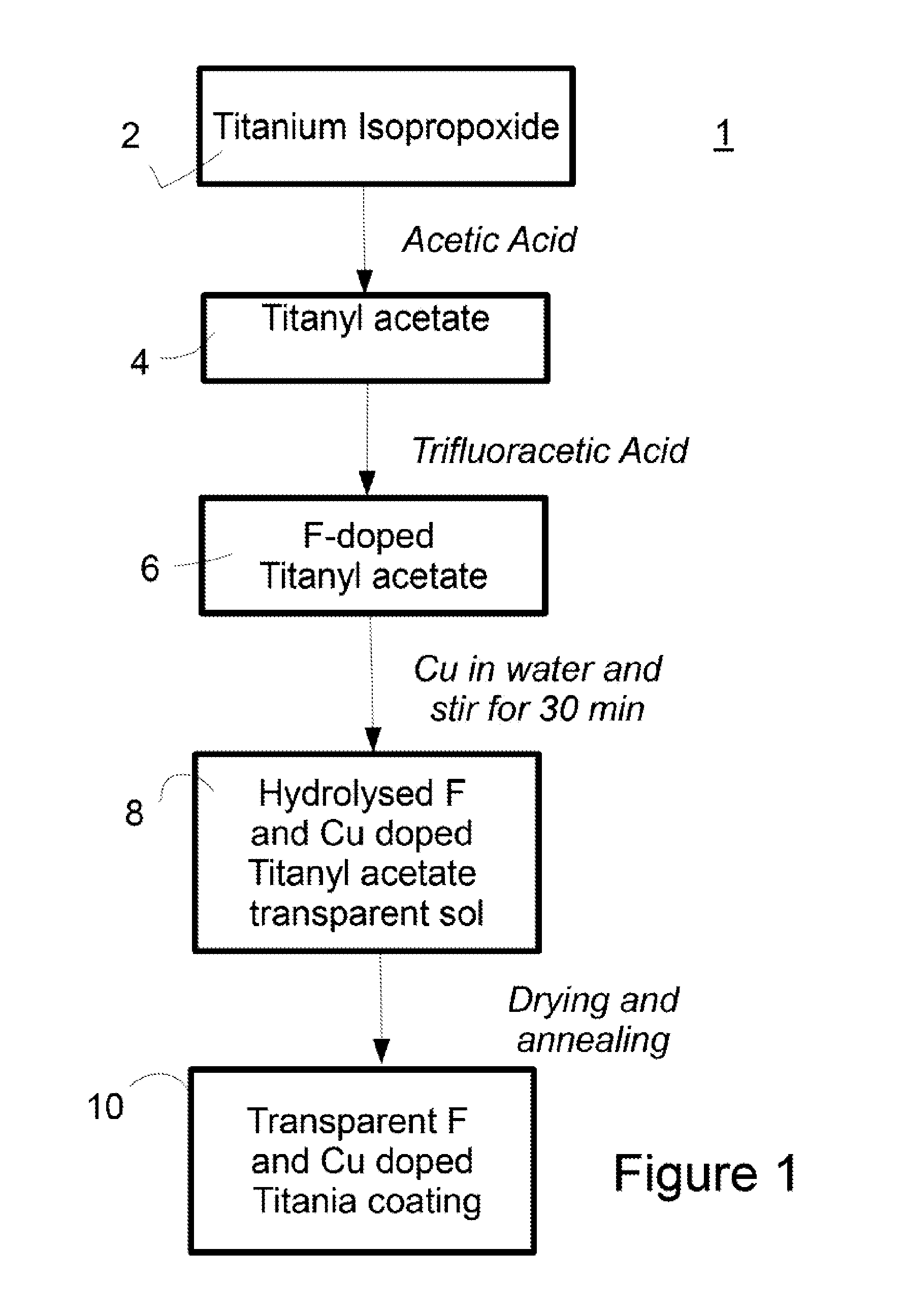Surface Coating
- Summary
- Abstract
- Description
- Claims
- Application Information
AI Technical Summary
Benefits of technology
Problems solved by technology
Method used
Image
Examples
example
Materials
[0072]Titanium isopropoxide (TIPP) (C12H28O4Ti) (Grade 97%; supplied by Sigma Aldrich under CAS Number: 546-68-9 (Cat. Number of supplier 205273-2L); Trifluoroacetic acid (TFA) (C2HF3O2) (Grade 99%, supplied by Sigma Aldrich as CAS Number: 76-05-1 (Cat. Number of supplier T6508-1 L); Glacial acetic acid (ACS≧99.7%; supplied by Sigma Aldrich under CAS Number: 64-19-7, Cat. Number of supplier 320099-2.5L); Deionised water;[0073]and, where employed, Copper (II) nitrate pentahemihydrate (Grade Puriss ACS; CAS Number: 10031-43-3 available from Riede-de Haën, of Germany as Cat. Number of supplier 31288).
[0074]The following sets out examples of ranges of each component that may be used for preparing a pure VLA solution and a doped VLA solution.
[0075]Weight Percentages
[0076]Example of Pure VLA[0077]Deionised water=(Range 40 to 99%, preferably 50 to 95%)[0078]Titanium isopropoxide=(Range 4 to 15%)[0079]Trifluroacetic acid=(Range 1 to 10%)[0080]Glacial acetic acid=(Range 10-20%)
[0081...
example 2
Antimicrobial testing of glass samples
[0127]Exposure time of sample was 24 hours with lighting conditions being:[0128]1. No light[0129]2. T5 light 1000 Lux (light box) in a moist environment (wet filter paper placed in petri dish)[0130]Tested organism: Staphylococcus aureus ATCC 6538[0131]Procedure followed was based on ISO 27447:2009 standard, modified for visible light activation.
[0132]Briefly, an overnight culture of S. aureus was washed with phosphate buffer saline (PBS) twice. For the analysis, each sample was aseptically placed in a sterile petri dish containing moist filter paper and inoculated with the bacterial suspension containing approximately 1×106 colony forming units (CFU) / sample. The prepared samples were divided into two groups (test sample (i.e. with coating) and control (no coating)). One of the control samples was tested immediately for viable bacterial count using the pour plate method in triplicate. Dilutions as far as 10−5 were made and were incubated aerobica...
PUM
| Property | Measurement | Unit |
|---|---|---|
| Temperature | aaaaa | aaaaa |
| Temperature | aaaaa | aaaaa |
| Temperature | aaaaa | aaaaa |
Abstract
Description
Claims
Application Information
 Login to View More
Login to View More - R&D
- Intellectual Property
- Life Sciences
- Materials
- Tech Scout
- Unparalleled Data Quality
- Higher Quality Content
- 60% Fewer Hallucinations
Browse by: Latest US Patents, China's latest patents, Technical Efficacy Thesaurus, Application Domain, Technology Topic, Popular Technical Reports.
© 2025 PatSnap. All rights reserved.Legal|Privacy policy|Modern Slavery Act Transparency Statement|Sitemap|About US| Contact US: help@patsnap.com


